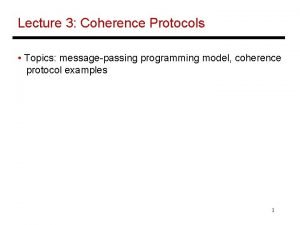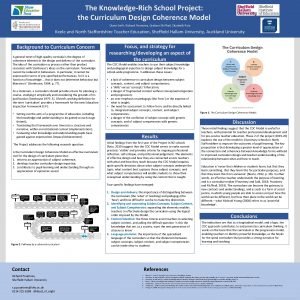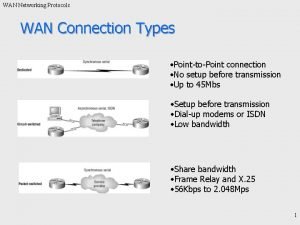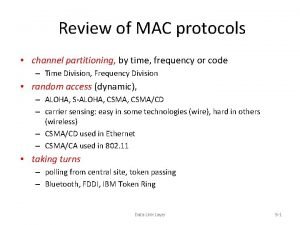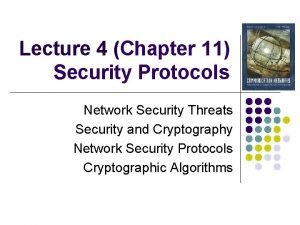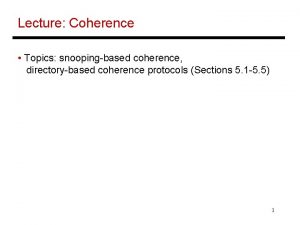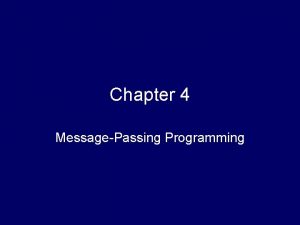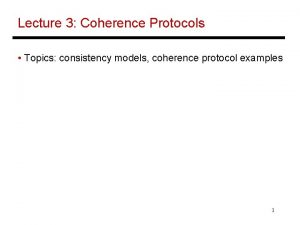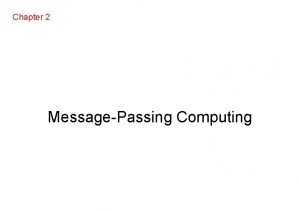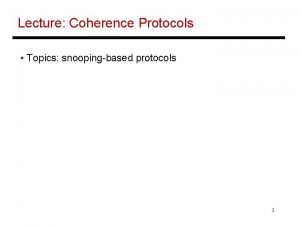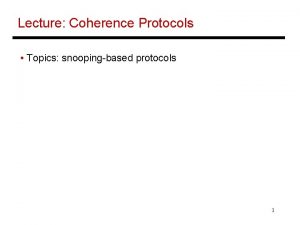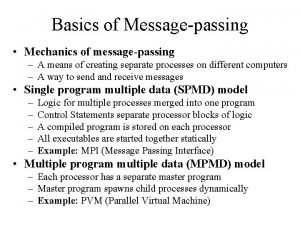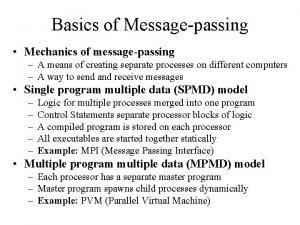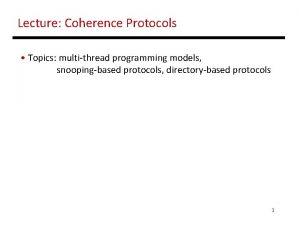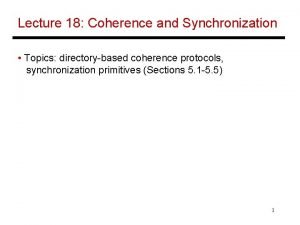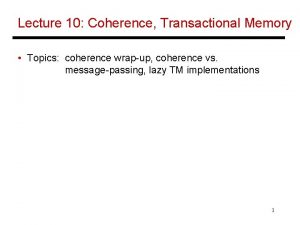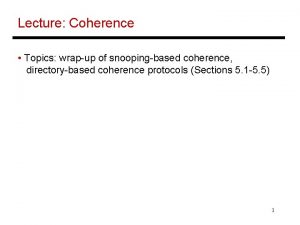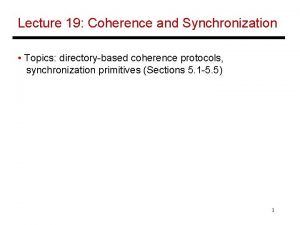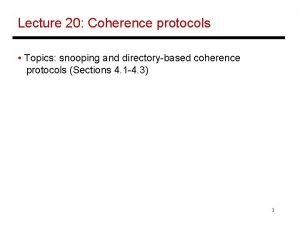Lecture 3 Coherence Protocols Topics messagepassing programming model


















- Slides: 18

Lecture 3: Coherence Protocols • Topics: message-passing programming model, coherence protocol examples 1

Ocean Kernel Procedure Solve(A) begin diff = done = 0; while (!done) do diff = 0; for i 1 to n do for j 1 to n do temp = A[i, j]; A[i, j] 0. 2 * (A[i, j] + neighbors); diff += abs(A[i, j] – temp); end for if (diff < TOL) then done = 1; end while end procedure 2

Shared Address Space Model int n, nprocs; float **A, diff; LOCKDEC(diff_lock); BARDEC(bar 1); main() begin read(n); read(nprocs); A G_MALLOC(); initialize (A); CREATE (nprocs, Solve, A); WAIT_FOR_END (nprocs); end main procedure Solve(A) int i, j, pid, done=0; float temp, mydiff=0; int mymin = 1 + (pid * n/procs); int mymax = mymin + n/nprocs -1; while (!done) do mydiff = 0; BARRIER(bar 1, nprocs); for i mymin to mymax for j 1 to n do … endfor LOCK(diff_lock); diff += mydiff; UNLOCK(diff_lock); BARRIER (bar 1, nprocs); if (diff < TOL) then done = 1; BARRIER (bar 1, nprocs); endwhile 3

Message Passing Model main() read(n); read(nprocs); CREATE (nprocs-1, Solve); Solve(); WAIT_FOR_END (nprocs-1); for i 1 to nn do for j 1 to n do … endfor if (pid != 0) SEND(mydiff, 1, 0, DIFF); RECEIVE(done, 1, 0, DONE); else for i 1 to nprocs-1 do RECEIVE(tempdiff, 1, *, DIFF); mydiff += tempdiff; endfor if (mydiff < TOL) done = 1; for i 1 to nprocs-1 do SEND(done, 1, I, DONE); endfor endif endwhile procedure Solve() int i, j, pid, nn = n/nprocs, done=0; float temp, tempdiff, mydiff = 0; my. A malloc(…) initialize(my. A); while (!done) do mydiff = 0; if (pid != 0) SEND(&my. A[1, 0], n, pid-1, ROW); if (pid != nprocs-1) SEND(&my. A[nn, 0], n, pid+1, ROW); if (pid != 0) RECEIVE(&my. A[0, 0], n, pid-1, ROW); if (pid != nprocs-1) RECEIVE(&my. A[nn+1, 0], n, pid+1, ROW); 4

Message Passing Model • Note that each process has two additional rows to store data produced by its neighbors • Unlike the shared memory model, execution is deterministic -- two executions will produce the same result • A send-receive match is a synchronization event – hence, we no longer need locks while updating the diff counter, or barriers while allowing processes to proceed with the next iteration 5

Models for SEND and RECEIVE • Synchronous: SEND returns control back to the program only when the RECEIVE has completed – will it work for the program on the previous slide? • Blocking Asynchronous: SEND returns control back to the program after the OS has copied the message into its space -- the program can now modify the sent data structure • Nonblocking Asynchronous: SEND and RECEIVE return control immediately – the message will get copied at some point, so the process must overlap some other computation with the communication – other primitives are used to probe if the communication has finished or not 6

Cache Coherence A multiprocessor system is cache coherent if • a value written by a processor is eventually visible to reads by other processors – write propagation • two writes to the same location by two processors are seen in the same order by all processors – write serialization 7

Cache Coherence Protocols • Directory-based: A single location (directory) keeps track of the sharing status of a block of memory • Snooping: Every cache block is accompanied by the sharing status of that block – all cache controllers monitor the shared bus so they can update the sharing status of the block, if necessary Ø Write-invalidate: a processor gains exclusive access of a block before writing by invalidating all other copies Ø Write-update: when a processor writes, it updates other shared copies of that block 8

Protocol-I MSI • 3 -state write-back invalidation bus-based snooping protocol • Each block can be in one of three states – invalid, shared, modified (exclusive) • A processor must acquire the block in exclusive state in order to write to it – this is done by placing an exclusive read request on the bus – every other cached copy is invalidated • When some other processor tries to read an exclusive block, the block is demoted to shared 9

Design Issues, Optimizations • When does memory get updated? Ø demotion from modified to shared? Ø move from modified in one cache to modified in another? • Who responds with data? – memory or a cache that has the block in exclusive state – does it help if sharers respond? • We can assume that bus, memory, and cache state transactions are atomic – if not, we will need more states • A transition from shared to modified only requires an upgrade request and no transfer of data • Is the protocol simpler for a write-through cache? 10

4 -State Protocol • Multiprocessors execute many single-threaded programs • A read followed by a write will generate bus transactions to acquire the block in exclusive state even though there are no sharers • Note that we can optimize protocols by adding more states – increases design/verification complexity 11

MESI Protocol • The new state is exclusive-clean – the cache can service read requests and no other cache has the same block • When the processor attempts a write, the block is upgraded to exclusive-modified without generating a bus transaction • When a processor makes a read request, it must detect if it has the only cached copy – the interconnect must include an additional signal that is asserted by each cache if it has a valid copy of the block 12

Design Issues • When caches evict blocks, they do not inform other caches – it is possible to have a block in shared state even though it is an exclusive-clean copy • Cache-to-cache sharing: SRAM vs. DRAM latencies, contention in remote caches, protocol complexities (memory has to wait, which cache responds), can be especially useful in distributed memory systems • The protocol can be improved by adding a fifth state (owner – MOESI) – the owner services reads (instead of memory) 13

Update Protocol (Dragon) • 4 -state write-back update protocol, first used in the Dragon multiprocessor (1984) • Write-back update is not the same as write-through – on a write, only caches are updated, not memory • Goal: writes may usually not be on the critical path, but subsequent reads may be 14

4 States • No invalid state • Modified and Exclusive-clean as before: used when there is a sole cached copy • Shared-clean: potentially multiple caches have this block and main memory may or may not be up-to-date • Shared-modified: potentially multiple caches have this block, main memory is not up-to-date, and this cache must update memory – only one block can be in Sm state • In reality, one state would have sufficed – more states to reduce traffic 15

Design Issues • If the update is also sent to main memory, the Sm state can be eliminated • If all caches are informed when a block is evicted, the block can be moved from shared to M or E – this can help save future bus transactions • Having an extra wire to determine exclusivity seems like a worthy trade-off in update systems 16

Examples MSI • P 1: Rd • P 1: Wr • P 2: Rd • P 2: Wr P 1 MESI Dragon MSI P 2 MESI Dragon X X X X Total transfers: 17

Title • Bullet 18
 Cache coherence protocols
Cache coherence protocols 01:640:244 lecture notes - lecture 15: plat, idah, farad
01:640:244 lecture notes - lecture 15: plat, idah, farad C programming lecture
C programming lecture Curriculum design coherence model
Curriculum design coherence model Perbedaan linear programming dan integer programming
Perbedaan linear programming dan integer programming Greedy vs dynamic programming
Greedy vs dynamic programming Definition of system programming
Definition of system programming Integer programming vs linear programming
Integer programming vs linear programming Definisi integer
Definisi integer Type
Type Utopian simplex protocol
Utopian simplex protocol Channel partitioning mac protocols
Channel partitioning mac protocols Proofs of work and bread pudding protocols
Proofs of work and bread pudding protocols Presentation layer design issues
Presentation layer design issues Network security protocols
Network security protocols Lgs pms
Lgs pms Network security protocols
Network security protocols Wan technologies overview
Wan technologies overview Wireless sensor network protocols
Wireless sensor network protocols
